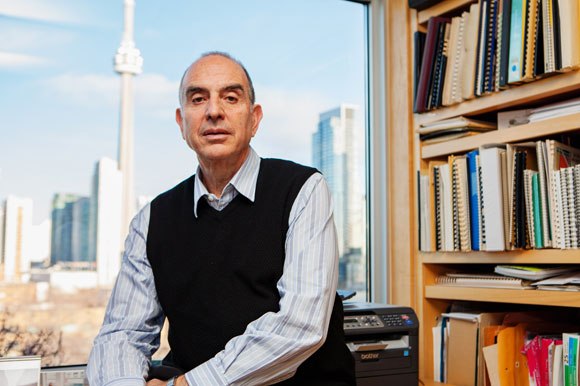There are few people in the city of Toronto more qualified to talk about city building than Ken Greenberg. The urban designer, teacher, writer, former Director of Urban Design and Architecture for the City of Toronto and Principal of Greenberg Consultants has helped reinvent and revitalize communities around the world for over thirty years. These days he teaches at the University of Toronto as an Adjunct Professor in the John H. Daniels Faculty of Architecture, Landscape and Design. He is also a co-founder and a Visiting Scholar at the new City Building Institute at Ryerson University in Toronto, and the author of
Walking Home: the Life and Lessons of a City Builder.
In anticipation of our May 20 Speakers Series panel on the future of downtown Yonge, we spoke with Greenberg about the street's role in shaping the city and the vision required, in turn, to shape the street.
 Yonge Street Media: It feels as though Yonge Street is naturally the epicentre of the city, but in fact that's probably the result of careful planning. Or maybe it's a little bit of planning, and a little bit of geographic luck.
Yonge Street Media: It feels as though Yonge Street is naturally the epicentre of the city, but in fact that's probably the result of careful planning. Or maybe it's a little bit of planning, and a little bit of geographic luck.
Ken Greenberg: It was where we put down the first subway line, where people from all parts of the city came to share music, shopping, strolling. It's always been that kind of place. I think going back to the 1970s, there's been a strong feeling that the role should shift to be more available to pedestrians, and less emphasis on vehicular traffic.
Coming closer to the present, I did a study with KPMB Architects in 2011 for Kristyn Wong-Tam and the BIA, and we looked in particular at the stretch between Dundas Square up to College Street. What was really interesting was that between Ryerson and the neighbourhoods of College Park, McGill Granby and Edward-Elm, there's a huge transformation of Yonge Street under way. It's becoming more diverse, with more people. And not surprisingly, we found that that stretch was being used by two-and-a-half times more pedestrians than people in cars.
That's really significant.
It is. The idea has been pursued ever since, to work to make sure that the built form and the uses on both sides of the street are sympathetic to the pedestrian character of Yonge Street. I know the councillors and BIA are actively pursuing that. In 2012 we did
Celebrate Yonge, which was a test of the idea, where we took out a leg of traffic. Not surprisingly, businesses saw a tremendous increase in sales and people just thoroughly enjoyed the street. The energy is really palpable, and I think people are really ready for it.
Do you anticipate a move toward further pedestrianization?
I think it's absolutely the direction that things are going in. I was talking specifically about that stretch of lower Yonge Street, but I think in the fullness of time this focus could extend down to the waterfront and all the way up to Bloor Street. Yonge Street deserves to be that kind of street.
Yonge Street has always been very accessible, maybe even a bit rough around the edges. With the rapid densification of downtown, is Yonge Street in danger of losing its unique character?
If you look at Dundas Square, which has been massively redeveloped, it still has that kind of everyman character. And I think people are sensitive to that. The BIA accepts the inevitability of change but is also cautious that we don't use that fine-grained character and heterogeneous quality. Yonge Street should never try to become Queen Street or Yorkville. It has its own character.
How did Yonge Street emerge as the city's uniting thoroughfare in the first place?
It goes back to pre-European times as a connection for native people down to the lake, so it has a very, very long history. My experience of it, coming to Toronto in the late-sixties and getting to know the city, Yonge Street was kind of like the part in the hair to use a funny metaphor. You had east enders and west enders, but Yonge Street has always been the common ground and place where major events are celebrated by everybody.